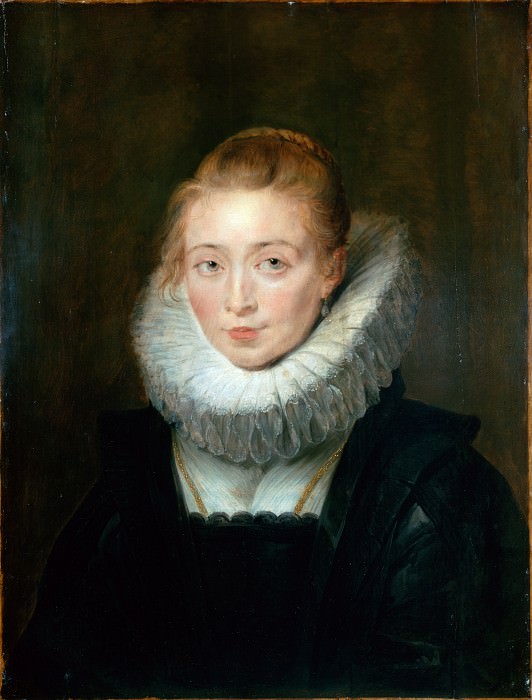The Maid of Honor to the Infanta Isabella Peter Paul Rubens (1577-1640)
Peter Paul Rubens – The Maid of Honor to the Infanta Isabella
Edit attribution
Image taken from other album: gallerix.org/s/1016087178/N/1941963673/
Download full size: 5139×6763 px (14,5 Mb)
Painter: Peter Paul Rubens
In 1625, Rubens created a pencil portrait of a chambermaid. He did not like this type of woman. Usually, his paintings show ladies striking with the opulence of their bodies. The artist depicted almost a girl. She is very young. This is a real flower, which is very fragile. In all the features one can feel the angularity of the child. After the drawing was finished, the artist decides to create an entire painting.
Description of Peter Rubens’ Portrait of the Infanta Isabella’s Chambermaid
In 1625, Rubens created a pencil portrait of a chambermaid. He did not like this type of woman. Usually, his paintings show ladies striking with the opulence of their bodies. The artist depicted almost a girl. She is very young. This is a real flower, which is very fragile. In all the features one can feel the angularity of the child.
After the drawing was finished, the artist decides to create an entire painting. Before that, Rubens had depicted grandiose canvases that thrilled his contemporaries. He was a true colossus. And suddenly he stopped his eyes on nothing, seemingly unremarkable lady. What happened?
The artist has put into this portrait all his experience. Rubens inherent mysteries. That is why the picture should be considered very long. A young woman of the 17th century is looking at the wall. We are separated by centuries. But the magic of the artist’s brushwork is astounding. It is impossible to see the open colors. Everything seems to fuse into a single gamut, which miraculously immerses the viewer in the era. It is as if we are breathing the same air as the artist.
The infanta’s eyes look at us slightly creepily and yet affectionately. Her eyebrows are slightly raised, as if Isabella is surprised by something. There is not a single wrinkle on her smooth face. She is not allowed to show any concern. But you can feel the tension in her thin nostrils, which flutter slightly. Her pupils are dilated. They, too, are maximally tense. They betray the heroine’s incredible excitement. At the same time, her lips are pressed together. An extra word will never get out of them.
The Infanta can masterfully keep all the secrets of the palace. The court simply does not like witnesses to any terrible secrets. But it is impossible to do without them. We feel very uncomfortable under this scrutiny that assesses everything.
This is not just a portrait, but an entire treatise. The artist analyzes the courtyard from a psychological point of view. His painting symbolizes the vanity of the struggle for power, which is essentially hollow.
Кому понравилось
Пожалуйста, подождите
На эту операцию может потребоваться несколько секунд.
Информация появится в новом окне,
если открытие новых окон не запрещено в настройках вашего браузера.
You need to login
Для работы с коллекциями – пожалуйста, войдите в аккаунт (open in new window).













![Peter Paul Rubens - The Death of Seneca [After]](http://cdn.gallerix.asia/j/_EX/754398988/6053.webp)






COMMENTS: 11 Ответы
Это взгляд мне в лицо, через бездну времени.
Самая притягивающая взгляд картина в Эрмитаже. Но почему Леди в ожидании? В былые времена, если я не ошибаюсь, под ней стояла надпись Портрет инфанты Изабеллы
Всё же ошибся – это Портрет камеристки инфанты Изабеллы
Полковник, спасибо что заметили ошибку, исправлено.
Оригинальное название картины: “Portrait of Lady-in-Waiting to the Infanta Isabella”.
Просто завораживающий взгляд и красивое лицо!
Мне кажется, нужно всё-таки исправить название. Полотно завораживающее, многие станут думать, что инфанта дома Габсбургов могла так выглядеть. В России издавна закрепилось имя – "Портрет камеристки"
это не Изабелла Клара Евгения, надо знать искусство...
Это по легенде дочь Рубенса, умершая рано,. изобразил ее как-бы она выглядела если-бы жила. Это знает любой художник.
Много лет это моя любимая картина, когда я бываю в Эрмитаже, всегда провожу возле нее не менее получаса. От нее веет таким покоем и умиротворением. А ее взгляд приносит в душу покой, и все плохое уходит далеко.
1625 год, время написания этой картины. Судя по всему, это Клара Серена, дочь Питера Пауля. Ей не удалось дожить до того возраста, запечатлённого на картине. В музее Лихтенштейна (Вадуц) есть набросок её лица, черты лица похожи. Картина была продана семейством Кроза и была куплена Екатериной IIдля Эрмитажа.
И мне нравится смотреть на эту картину
You cannot comment Why?
The subtext of the painting likely revolves around themes of status, wealth, and individual identity within the context of the Spanish Netherlands in the 17th century. The elaborate ruff and rich fabric of her clothing signify her connection to the aristocracy or a wealthy household, and her role as a maid of honor to the Infanta Isabella reinforces this. The direct gaze and serene demeanor might suggest a quiet confidence and awareness of her position. The portrait serves to document her appearance and, by extension, her social standing during this historical period. The subtle use of light and shadow could also be interpreted as hinting at the complexities of life within a courtly environment.